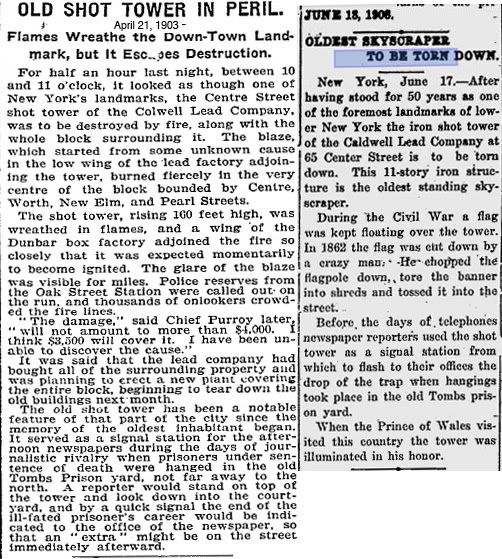Early History in America
In 1807, Thomas Jefferson had congress pass the Embargo Act of 1807 which forbade all international trade to and from American ports, and Jefferson hoped that Britain and France would be persuaded of the value and the rights of a neutral commerce. This was the end of importing lead shot from England, France and the rest of Europe where shot towers produced tons of shot for American export. European shot towers had sprung up all over Europe after the construction of the first shot tower by William Watts in 1783 in Bristol, England and the American colonies were major buyers.
With this turn of events (Jefferson's embargo), shot towers began to be constructed in the colonies for American consumption. The first two were in Philadelphia (Sparks Shot Tower) in 1808 and the Jackson Ferry Tower in Wytheville, Virginia in 1807. Both these towers produced shot and bullets for the War of 1812. The Sparks Shot Tower in Philadelphia is the first "smoke stack" type tower in America. The tower produced tons of ammunition during the War of 1812 and the Civil War. Four generations of the Sparks family kept the tower in operation until 1903. The tower is now part of a city playground with a recreation center at the base. It's a prime example of Philadelphia's reputation for superb brickwork. The operation was completely above ground while the Jackson Ferry Tower in Wytheville, built one year earlier, has much of it's drop underground. The combined drop (above and below ground) of the Jackson Ferry Tower is 150' with the above ground rectangular tower standing 75 feet and the underground shaft another 75 feet.
In 1774 Thomas Jefferson purchased 157 acres of land including the Natural Bridge in the Shenandoah Valley of Virginia from King George III of England for 20 shillings. Later, Jefferson himself used the "Watts Method" of making shot by dropping molten lead from the top of the Natural Bridge into the stream below. That small stream is Cedar Creek.
Early shot towers where found in the New England states in the early 18th century and flourished in New York, Pennsylvania and Virginia, where they were used in the manufacture of lead shot for shotguns.
An example of a shot tower was the Youle Shot Tower, built around 1830 on the banks of the East River, beyond Kip's Bay on Manhattan Island in the state of New York. The owner, George Youle, was a dry goods merchant. This particular shot tower operated for years and was quite productive, selling much of its inventory to hardware and sporting goods dealers in New York and Pennsylvania. In turn, the dealers supplied the Indian Bureau, the American Fur Trade and a number of suppliers in the south and west.


No comments:
Post a Comment